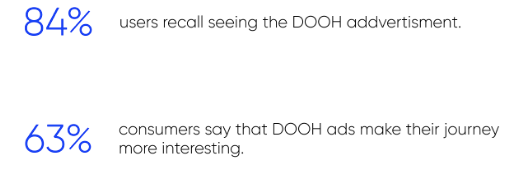What is DOOH ads?
What is it?
Digital out of home is an advertising channel where promotional media is placed in public places: on the streets, cafes, bus stops, parking and so on.
Here are typical examples of digital out-of-home advertising:
- Full-sized digital billboards on the highway
- Digital video displays in Wi-Fi terminals
- Advertisements on commercial jet screens
- Screens in elevators
As digital screens replace paper, paste, and paint, a brand’s messages can be changed at any time, providing brands more flexibility, and creativity, and leaving a lasting impression on users.
What goals can it help achieve?
- increase brand awareness;
- improve loyalty of audiences;
- boost reach of ad campaigns;
- drive conversions and so on.
Ad formats
- Indoor. There is a form of digital out-of-home advertising that can be found inside. In fact, this type helps advertisers to reach a niche audience when they’re in a contextually relevant environment: near lifts, at a restaurant, grocery store, parking and so on.
- Outdoor digital OOH allows brands to catch audience attention on the streets through digital billboards, media facades, supersides, etc.
Brands can choose banners ads as well as video advertisements. It depends on the brand’s goal.
Targeting
Brands have the ability to target via demographic, geographic, income group, time, weather, and even temperatures around the screen.
With DOOH advertising, brands receive information about the playtime of their ads. They can deliver ads messages without going irrelevant and inopportune for the target audience.
How does it work?
The buying process is automatic. Programmatic technology allows the integration of real time beading into DOOH ads.
Digital screens are equipped with special detectors which recognize and read MAC-address to define users. With mac-addresses the nearest audience is caught, they combine in profile of the audience and analyze. If there is a high concentration of the target audience, the ad impression will buy and users will see brands’ messages.
Payment model
CPM per 1000 Opportunity to See (OTS) is a key payment model for digital OOH media. This means marketers are paying for real contacts of users with advertisements. OTS is determined considering viewshed — the geographical area that is visible from a location. It includes all surrounding points that are in line-of-sight with digital OOH placement, and takes into account fixed characteristics such as the size, distance from the audience and position to the audience of an digital OOH media ad. For instance, if users are behind a digital billboard and can’t see an advertisement, then that won’t be determined as OTS.
Benefits
- More targeting capabilities and precise targeting options compared with OOH.
- More flexibility and a wide outreach of target audience on their go.
- No place for banner blindness and ad blockers.
- Better measurement and tracking ad performance in real-time.
- Boost performance of multi-channel ad campaigns.
- Opportunity to reach users offline through the entire customer journey.
